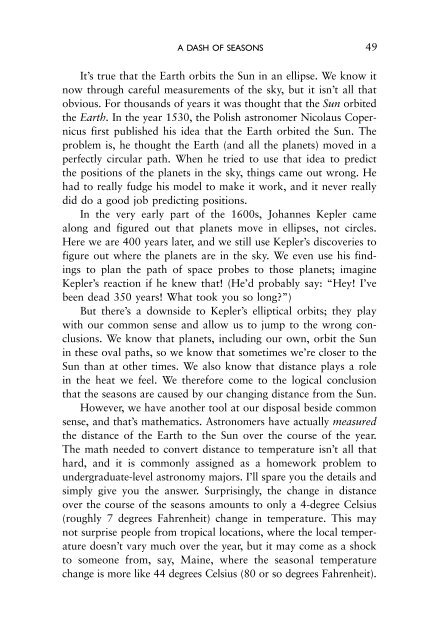Bad Astronomy: Misconceptions and Misuses Revealed, from ...
Bad Astronomy: Misconceptions and Misuses Revealed, from ...
Bad Astronomy: Misconceptions and Misuses Revealed, from ...
Create successful ePaper yourself
Turn your PDF publications into a flip-book with our unique Google optimized e-Paper software.
A DASH OF SEASONS 49<br />
It’s true that the Earth orbits the Sun in an ellipse. We know it<br />
now through careful measurements of the sky, but it isn’t all that<br />
obvious. For thous<strong>and</strong>s of years it was thought that the Sun orbited<br />
the Earth. In the year 1530, the Polish astronomer Nicolaus Copernicus<br />
first published his idea that the Earth orbited the Sun. The<br />
problem is, he thought the Earth (<strong>and</strong> all the planets) moved in a<br />
perfectly circular path. When he tried to use that idea to predict<br />
the positions of the planets in the sky, things came out wrong. He<br />
had to really fudge his model to make it work, <strong>and</strong> it never really<br />
did do a good job predicting positions.<br />
In the very early part of the 1600s, Johannes Kepler came<br />
along <strong>and</strong> figured out that planets move in ellipses, not circles.<br />
Here we are 400 years later, <strong>and</strong> we still use Kepler’s discoveries to<br />
figure out where the planets are in the sky. We even use his findings<br />
to plan the path of space probes to those planets; imagine<br />
Kepler’s reaction if he knew that! (He’d probably say: “Hey! I’ve<br />
been dead 350 years! What took you so long?”)<br />
But there’s a downside to Kepler’s elliptical orbits; they play<br />
with our common sense <strong>and</strong> allow us to jump to the wrong conclusions.<br />
We know that planets, including our own, orbit the Sun<br />
in these oval paths, so we know that sometimes we’re closer to the<br />
Sun than at other times. We also know that distance plays a role<br />
in the heat we feel. We therefore come to the logical conclusion<br />
that the seasons are caused by our changing distance <strong>from</strong> the Sun.<br />
However, we have another tool at our disposal beside common<br />
sense, <strong>and</strong> that’s mathematics. Astronomers have actually measured<br />
the distance of the Earth to the Sun over the course of the year.<br />
The math needed to convert distance to temperature isn’t all that<br />
hard, <strong>and</strong> it is commonly assigned as a homework problem to<br />
undergraduate-level astronomy majors. I’ll spare you the details <strong>and</strong><br />
simply give you the answer. Surprisingly, the change in distance<br />
over the course of the seasons amounts to only a 4-degree Celsius<br />
(roughly 7 degrees Fahrenheit) change in temperature. This may<br />
not surprise people <strong>from</strong> tropical locations, where the local temperature<br />
doesn’t vary much over the year, but it may come as a shock<br />
to someone <strong>from</strong>, say, Maine, where the seasonal temperature<br />
change is more like 44 degrees Celsius (80 or so degrees Fahrenheit).
















